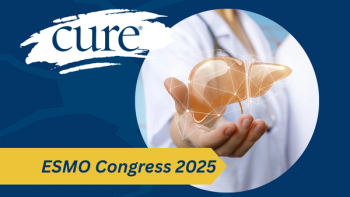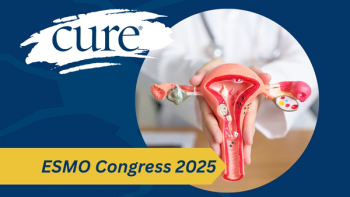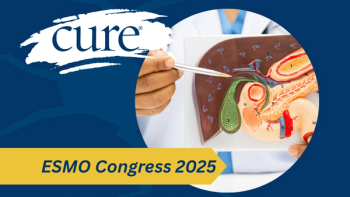
Novel Therapy Shows Promise in Liver Cancer Subset, May Address ‘Urgent Need for New Therapies’
“Along with a tolerable safety profile and supportive quality of life, these final efficacy results demonstrate the clinical benefit of (Tibsovo) in (previously treated patients with IDH1-mutant cholangiocarcinoma), for which there is an urgent need for new therapies,” said an expert from Massachusetts General Hospital, who presented the data.
Data from a final analysis of the phase 3 ClarlDHy trial demonstrated that treatment with Tibsovo (ivosidenib) tablets reduced the risk of death by 21% in previously treated patients with IDH1-mutant cholangiocarcinoma, compared to placebo.
“The ClarlDHy study represents the first phase 3 study of a targeted, oral therapeutic with a noncytotoxic mechanism of action in advanced IDH1-mutant cholangiocarcinoma,” lead study author Dr. Andrew X. Zhu, director of Liver Cancer Research at Massachusetts General Hospital, said in a virtual presentation of the data during the 2021 American Society of Clinical Oncology Gastrointestinal Cancers Symposium. “Along with a tolerable safety profile and supportive quality of life, these final efficacy results demonstrate the clinical benefit of (Tibsovo) in this patient population, for which there is an urgent need for new therapies.”
Cholangiocarcinoma is a rare and aggressive cancer of the bile ducts in and outside the liver, and IDH1 mutations account for approximately 20% of intrahepatic cholangiocarcinoma cases.
Patients with localized disease are normally treated with surgery, radiation, and/or other ablative treatments, but there are currently no approved systemic therapies to treat patients with IDH1-mutated disease, according to the study authors.
The international, randomized, phase 3 trial comprised 187 previously treated patients (median age, 62 years) with IDH1-mutant cholangiocarcinoma who were randomized 2:1 to receive oral Tibsovo 500 mg daily (126 patients) or placebo (61 patients). Patients from the placebo arm were permitted to crossover to receive the study drug following signs of disease progression.
Almost half of the patients (46.7%) received two previous lines of therapy, while the remainder received one. A significant amount of the patients presented to the study with intrahepatic disease (92.4%), and 92.3% had metastatic disease.
Measuring progression-free survival (length of time during and after cancer treatment that a patient is alive, but the disease does not get worse) was the main goal of the study. Other goals of the study were to assess overall survival, objective response rate (the proportion of patients who had a complete or partial response to treatment), safety and tolerability and health-related quality-of-life.
Previously reported data from the trial demonstrated that Tibsovo reduced the risk of disease progression or death by 63% in this patient population, compared to placebo. At the time of reporting, median progression-free survival in the study drug arm was 2.7 months versus 1.4 months in the placebo arm. Six- and 12-month progression-free survival rates were 32% and 22% in patients who received Tibsovo. However, patients who received placebo did not remain progression-free at either timepoint.
At the time of previous publication, the median overall survival in the Tibsovo arm was 10.8 months compared to 9.7 months in the placebo arm. At six months, 67% of patients who received study drug remained alive versus 59% of those who received placebo.
The results presented during this meeting included longer follow-up, with a data cutoff of May 31, 2020. Many of the patients (70.5%) had crossed over from placebo to receive Tibsovo. However, 18 patients in the placebo arm did not crossover to study drug because of a multitude of reasons including, but not limited to, death (12 patients) and withdrawal of consent (2 patients). There were treatment discontinuations in both the Tibsovo and placebo arms, which were mostly attributed to disease progression (74.8% versus 86.4%, respectively).
The median duration of treatment of patients who received Tibsovo was 2.8 months versus 1.6 months for those who received placebo; patients who crossed over to receive study drug had a median treatment duration of 2.7 months. Twenty-five patients remained on Tibsovo treatment for at least one year; this includes six patients who crossed over from the placebo group.
The updated results demonstrated that patients who received study drug achieved a median overall survival of 10.3 months compared to 7.5 months in those who received placebo. The six-month overall survival rate remained higher in patients who received study drug (69%) compared to those who received placebo (57%). One-year overall survival was also better in patients who received study drug (43%) versus those who received placebo (36%). Neither six-month nor one-year overall survival rates were adjusted for the patients who crossed over to receive study drug.
The updated results demonstrated that the most common treatment-emergent adverse effects across both study drug and placebo group included: nausea (38% versus 28.8%), diarrhea (33.1% versus 16.9%), fatigue (28.9% versus 16.9%), abdominal pain (22.3% versus 15.3%), cough (21.7% versus 8.5%) and decreased appetite (21.7% versus 18.6%), respectively.
More serious or severe treatment-emergent adverse events occurred in 53% of patients treated with Tibsovo, which included those who crossed over from the placebo arm. Patients in the placebo arm also reported experiencing more severe or serious adverse events (37.3%), but they were less than the study drug arm.
Based on these data, Agios Pharmaceuticals, the developer of Tibsovo, plans to submit a supplemental new drug application for use of the treatment in this setting in the first quarter of 2021
For more news on cancer updates, research and education, don’t forget to
A version of this article originally appeared on OncLive® as “





